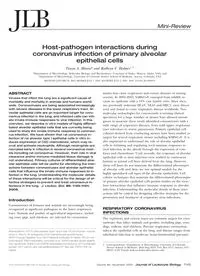
2009 Host-pathogen interactions during coronavirus infection of primary alveolar epithelial cells PDF
Preview 2009 Host-pathogen interactions during coronavirus infection of primary alveolar epithelial cells
Host-pathogen interactions during coronavirus infection of primary alveolar epithelial cells Tanya A. Miura* and Kathryn V. Holmes†,1 *Department of Microbiology, Molecular Biology, and Biochemistry, University of Idaho, Moscow, Idaho, USA; and †Department of Microbiology, University of Colorado Denver School of Medicine, Aurora, Colorado, USA RECEIVED JANUARY 28, 2009; REVISED JULY 1, 2009; ACCEPTED JULY 2, 2009. DOI: 10.1189/jlb.0209078 ABSTRACT Viruses that infect the lung are a significant cause of morbidity and mortality in animals and humans world- wide. Coronaviruses are being associated increasingly with severe diseases in the lower respiratory tract. Al- veolar epithelial cells are an important target for coro- navirus infection in the lung, and infected cells can initi- ate innate immune responses to viral infection. In this overview, we describe in vitro models of highly differen- tiated alveolar epithelial cells that are currently being used to study the innate immune response to coronavi- rus infection. We have shown that rat coronavirus in- fection of rat alveolar type I epithelial cells in vitro in- duces expression of CXC chemokines, which may re- cruit and activate neutrophils. Although neutrophils are recruited early in infection in several coronavirus mod- els including rat coronavirus. However, their role in viral clearance and/or immune-mediated tissue damage is not understood. Primary cultures of differentiated alve- olar epithelial cells will be useful for identifying the inter- actions between coronaviruses and alveolar epithelial cells that influence the innate immune responses to in- fection in the lung. Understanding the molecular details of these interactions will be critical for the design of ef- fective strategies to prevent and treat coronavirus in- fections in the lung. J. Leukoc. Biol. 86: 1145–1151; 2009. Introduction Coronaviruses of humans and animals are increasingly being recognized as significant pathogens in the lower respiratory tract. Animals and poultry of agricultural importance, includ- ing cows, pigs, and chickens, are infected by coronavirus strains that cause respiratory and enteric diseases of varying severity. In 2002–2003, SARS-CoV emerged from wildlife to cause an epidemic with a 10% case fatality ratio. Since then, two previously unknown HCoV, NL63 and HKU1, were discov- ered and found to cause respiratory disease worldwide. New molecular technologies for concurrently screening clinical specimens for a large number of viruses have allowed investi- gators to associate these newly identified coronaviruses with a wide range of respiratory diseases, from mild upper respiratory tract infections to severe pneumonia. Primary epithelial cell cultures derived from conducting airways have been studied as targets for several respiratory viruses including SARS-CoV. It is also important to understand the role of alveolar epithelial cells in initiating and regulating local immune responses to viral infection in the alveoli through the expression of cyto- kines and chemokines. Until recently, the responses of alveolar epithelial cells to virus infection were studied in continuous human or animal cell lines derived from the lung. However, these cell lines do not maintain the differentiated phenotypes of alveolar cells and thus, are not optimal models for the highly specialized cell types of the alveolar epithelium. Cell culture techniques that maintain the differentiated phenotypes of primary alveolar epithelial cells permit studies on the virus/ host interactions that influence immune responses to alveolar infection. Understanding the molecular details of these inter- actions will be critical for designing effective strategies for the prevention and treatment of respiratory virus infections. RESPIRATORY CORONAVIRUS INFECTIONS The repiratory and enteric tracts are common targets for coro- naviruses that infect animals and poultry, including pigs, cows, dogs, rodents, and chickens. Porcine respiratory coronavirus infects the epithelial cells of the lung, and disease ranges from subclinical infection to moderate bronchointerstitial pneumo- 1. Correspondence: Department of Microbiology, University of Colorado Denver School of Medicine, Mail Stop 8333, P.O. Box 6511, Aurora, CO 80045, USA. E-mail:
